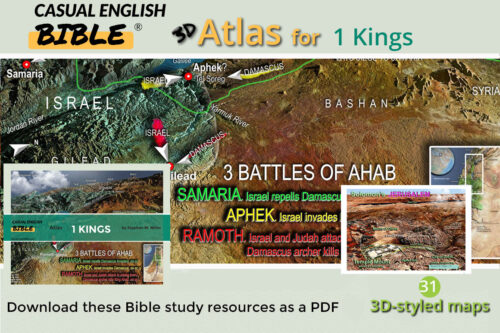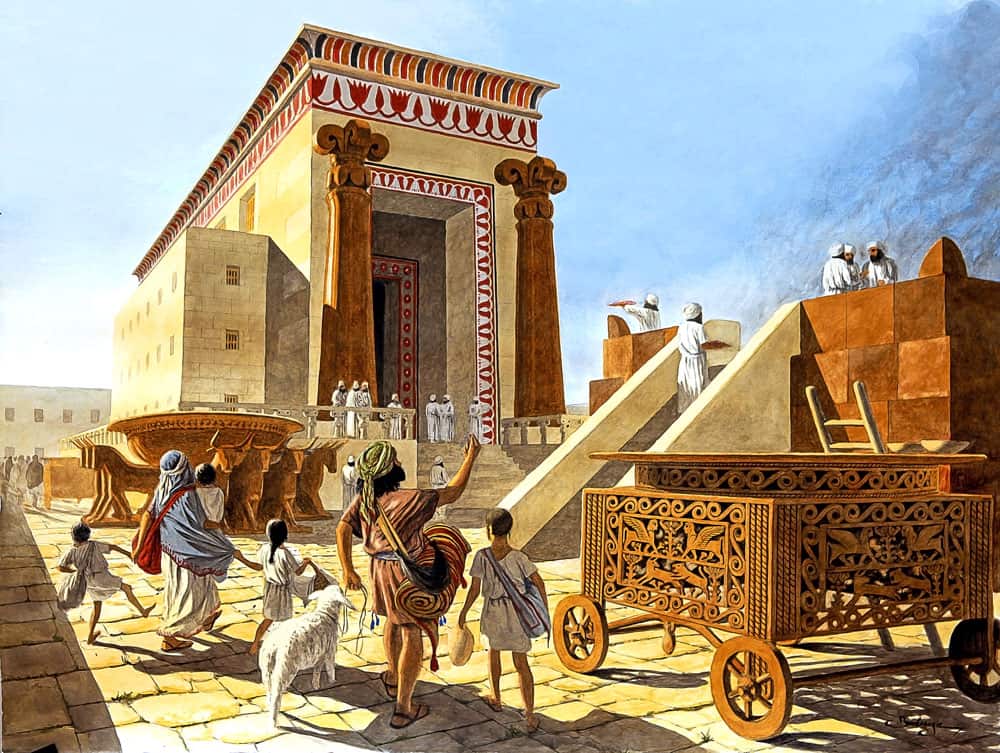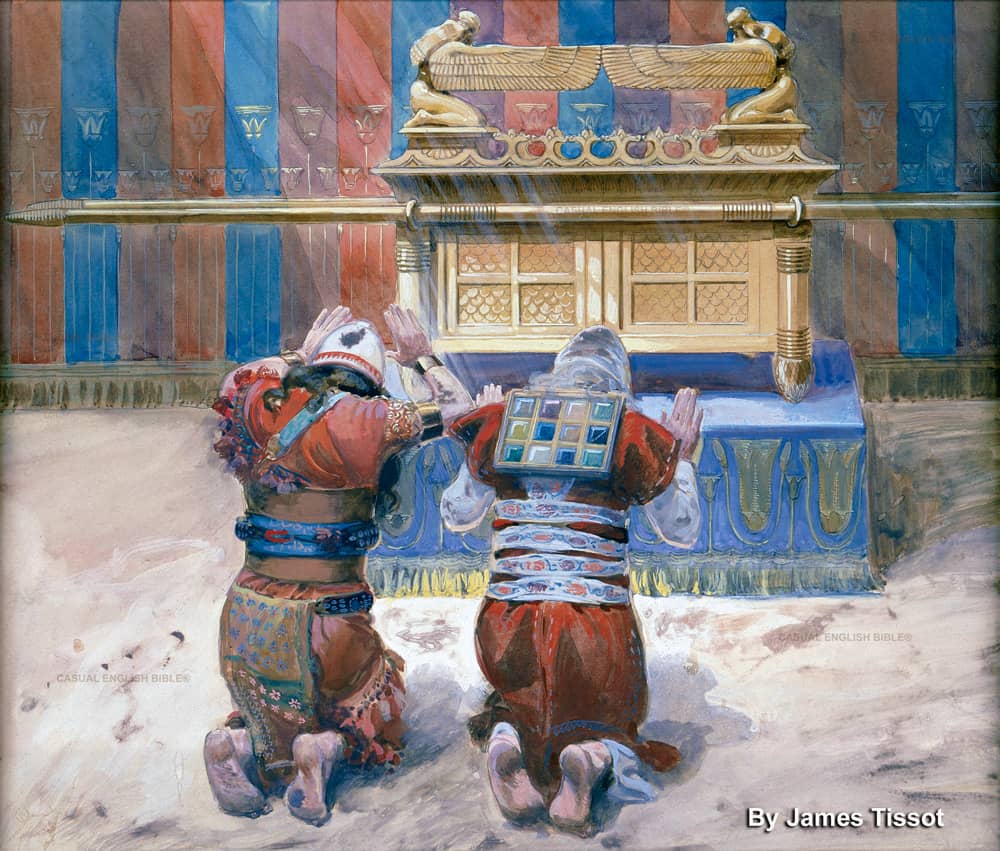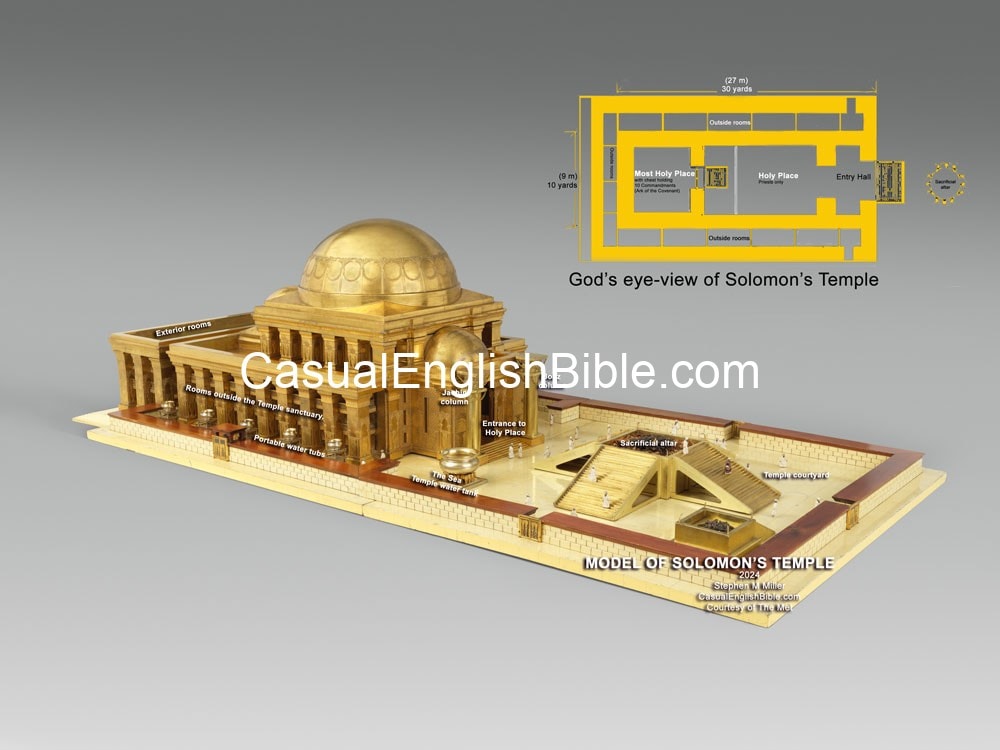1 Kings 6
Israel’s first permanent Temple
Work on the Temple begins in springtime
1Solomon started work on the Jerusalem Temple 480 [1] years after his Israelite ancestors escaped slavery in Egypt. Solomon was into his fourth year as king when work began in the springtime month of Ziv. [2]2Jerusalem’s first Temple measured 30 yards long, 10 yards wide, and 15 yards high. [3] 3Builders added a front porch 5 yards [4] deep, stretching all the way across the front of the building, for 10 yards.
4Solomon’s workers installed recessed window openings—wide on the outside and narrow on the inside.
Storage buildings attached to the Temple
5Workers wrapped three sides of the Temple—both sides and the back—with narrow buildings three stories high. 6Stoneworkers and carpenters built ground-floor rooms 7 ½ feet [5] wide. That was from the outside Temple wall to the opposite walls in the rooms. Second-floor rooms were 9 feet wide, and third-floor rooms 10 ½ feet wide.No hammering at the Temple
7Stone workers built the Temple walls with cut stone. When they worked onsite, where the Temple was located, they worked as quietly as possible. There were no sounds of a hammer, ax, or any other thundering iron tools. Stonecutters had to chisel their stones to fit offsite.8Priests went into the outer buildings through a doorway on the south side of the Temple, ground floor. Inside, a winding staircase led them to the upper floors. 9When stone artisans finished building the outside of the Temple, carpenters roofed it with cedar beams and planks across the beams. 10Workers used cedar timber to tie the three-story outer buildings to the main part of the Temple. They built each story 7 ½ feet high. [6]
God’s promise to stay with Israel
11God gave Solomon a message. 12“This is about the sacred house you built for me. I’ll make the same promise to you that I made to your father, David. 13If you live by the rules I’ve given you, and obey those laws, I’ll live here among the people of Israel. I won’t abandon them.”14Solomon finished the Temple.
Inside the Temple
2 Chronicles 3:8-14 15His builders used cedar boards to lay the Temple floor, line the inside walls, and place the rafters. 16Folks called the main room in the Temple the Holy Place. And in the back of the Holy Place, Solomon had them build a small room, the Most Holy Place. [7] It was a cedar-lined cube, 30 feet [8] on all sides. It had a separate entrance, which made it a private room. 17 The Holy Place was the largest room in the Temple, the sanctuary, 60 feet [9] long. It was the room in front of the Most Holy Place.
18Artisans decorated the cedar paneling inside the room with engraved art from nature—gourds and blooming flowers. From the floor to the top of the walls, every stone was draped in cedar. 19The Most Holy Room was most holy because it held the chest with the Ten Commandments, known as the Ark of the Covenant of the LORD. [10] The golden room
20Solomon had the inside of that room paneled with gold. The room was a cube, 30 feet on every side, floor to ceiling. [11] 21In addition to paneling the Most Holy Room with gold, Solomon added gold chains across the doorway into the room.
22He also had workers panel gold throughout the rest of the inside of the Temple. [12] And overlaid [13] gold onto the altar inside the Most Holy Room. Identical twin giant cherubim
23For the Most Holy Room, Solomon added two identical cherubim, [14] 15-feet high, [15] carved from the hard wood of olive trees. 24The cherubim had wings, with a wingspan as wide as they were tall. Each wing measured 7 ½ feet to the tip. 25Each cherub looked like the other. Identical twins with wings. 26One cherub was 15 feet tall, and so was the other.
27Solomon took the cherubim out of public view. He put them inside the Most Holy Place. The cherubim stood so close together that their wings tips touched. 28Solomon had the cherubim overlaid with gold. 29He also had the walls of both rooms inside the Temple decorated with wood engravings: cherubim, palm trees, and blooming flowers. 30Solomon also ordered the workers to add gold plates into the floors of both rooms. Most Holy Door
31For the doorway into the back room, the Most Holy Place, Solomon ordered two hardwood doors made from olive trees. The doorposts and the lintel beam above the door were shaped like five-sided pillars. 32He had the two olivewood doors decorated with carved pictures of cherubim, palm trees, and blooming flowers. And then he had them overlaid with gold leaf. Front door
33Solomon ordered four-sided olive wood doorposts for the front of the Temple. 34These doorposts helped frame the Temple’s two cypress doors, which opened into the main room—the Holy Place. Carpenters built each door to fold in on itself.
35Artisans decorated the door with carved cherubim, palm trees, and blooming flowers. Workers overlaid this art with an even layer of gold leaf. 36Three layers of cut stone and cedar beams formed the wall around the inner courtyard on the Temple complex—the courtyard closest to the front doors. Two layers were stone, one was cedar.
37Solomon ordered the Temple foundation built in the fourth year of his reign, in the springtime month of Ziv. [16] 38Workers finished the Temple a little more than seven years later, in the late-autumn month of Bul. [17] This was during Solomon’s eleventh year of reign. Footnotes
16:1The fourth year of Solomon’s reign is often dated to 966 BC. Well, 966 plus 480 years of history adds up to 1446 BC, the supposed date Moses led the Hebrew to freedom. There are almost no premier Christian scholars of biblical history who seem to buy that early date. They say Egyptian history and Holy Land archaeology suggest a date about 200 years after that, in the 1200’s BC. So, they argue that the writer, who has earned a reputation for using symbolic numbers throughout his reporting, may be thinking symbolically about 480. Multiply 4 times 12 times 10 and we get 480. Elsewhere in Jewish writing, four can refer to the four mothers of the Jewish people: Sarah, Rebecca, Rachel, and poor Leah, second in Jacob’s heart to Rachel. Ten could be a reminder of the Ten Commandments, Israel bedrock laws on which all other laws are built. Twelve represents Israel, all 12 tribes. We don’t think like this today. But the ancients did. They didn’t have TV, video games, or Black Fridays.
26:1Ziv runs from mid-April to mid-May.
36:2That’s 27 by 9 by 13.5 meters. Some say this is inside of the Temple, not outside. In either case, the measurement doesn’t include storage rooms and living quarters attached to the outside of the Temple sanctuary (see 6:5). In the Hebrew system of measurements, the main part of the Temple without the outlying buildings, was 60 by 20 by 30 cubits. A cubit was the length of a man’s forearm, from elbow to fingertips. That’s roughly 18 inches or half a meter. Solomon built the Temple on the Jerusalem ridge where the Holy Land’s most famous landmark has stood for the past 1,400 years: Islam’s shrine, the Dome of the Rock.
46:3Four and a half meters, or 10 cubits.
56:6Two meters for the ground floor, with 2 ½ meters for the second floor, and a little over 3 meters for the third floor.
66:10Two meters.
76:16Also known as the Holy of Holies.
86:16Nine meters.
96:17About 18 meters. In Hebrew, 40 cubits.
106:19This gold-lined wooden chest was Israel’s most sacred relic. It was lost to history, possibly captured, and stripped of its gold by one of Jerusalem’s invaders. Babylonians leveled the Temple in 586 BC. There’s no mention of the chest’s existence after that.
116:20The Hebrew phrasing says something that’s unclear. Some translate it like this: “They covered the altar with cedar.” Or “They built an altar.” But those are guesses based on just three Hebrew words: sapa, mizbeah, and erez. That could mean: overlaid, altar, cedar. But there are other meanings for those Hebrew words, too. They could mean: paneled, done, cedar. Educated guesses about how to interpret confusing collection of words like this are often based on context and the most common understanding of those words preserved in ancient writings of the time.
126:22It could sound like workers covered the entire inside of the Temple with gold. But earlier, the writer reported decorations of engraved cedar. Perhaps the inside of the Temple had both: gold panels, cedar, and gold leaf highlighting some cedar engravings.
136:22People have been using gold overlay for thousands of years, some say about 8,000 years. Metalworkers create an alloy, binding gold to another metal, often brass or copper. Gold bonds well and it makes the overlay metal strong and beautiful. To cover something like a wooden statue, artisans sanded and cleaned the wood and applied some kind of glue, such as egg whites or yolks or boiled animal parts that turn to gelatin. Then they placed the thin layer of gold leaf metal onto the wood with gentle pressure from their hands. When the glue dried, artisans removed any excess gold leaf. Then they sealed it with a kind of shellac, such as tree sap or the secretions of female lac bugs—lac as in lacquer.
146:23Kerubim in Hebrew. These are celestial beings mentioned throughout the Bible. Ancient Middle Eastern creatures with similar names, such as kirubu, reportedly served other gods. The creatures were portrayed in statues of beings such as human-headed lions with wings. These statues guarded entrances to cities and palaces. Jews taught that God’s footrest was the lid on the Ark of the Covenant, the gold-covered chest that held the Ten Commandments (1 Chronicles 28:2). Two winged beings called cherubim rested at each end of the lid. That’s in addition to the pair of huge cherubim in the room, standing as though on guard duty for God. Or perhaps waiting for orders to deliver a message.
156:23That’s 4 ½ meters, or in Hebrew, 15 cubits.
166:37See footnotes for 6:1.
176:38The Hebrew month of Bul runs across parts of October and November, with the cycle of the moon. Jews in Bible times followed a lunar calendar, with every month starting at the first tiny crescent after the new moon. A new moon is when the moon is hidden behind earth’s shadow for one day. The sun, moon, and earth are aligned, with earth in the middle, and the moon in the shade.
Discussion Questions
- Sorry, there are currently no questions for this chapter.
Videos
18Artisans decorated the cedar paneling inside the room with engraved art from nature—gourds and blooming flowers. From the floor to the top of the walls, every stone was draped in cedar. 19The Most Holy Room was most holy because it held the chest with the Ten Commandments, known as the Ark of the Covenant of the LORD. [10]
The golden room
20Solomon had the inside of that room paneled with gold. The room was a cube, 30 feet on every side, floor to ceiling. [11] 21In addition to paneling the Most Holy Room with gold, Solomon added gold chains across the doorway into the room.22He also had workers panel gold throughout the rest of the inside of the Temple. [12] And overlaid [13] gold onto the altar inside the Most Holy Room.
Identical twin giant cherubim
23For the Most Holy Room, Solomon added two identical cherubim, [14] 15-feet high, [15] carved from the hard wood of olive trees. 24The cherubim had wings, with a wingspan as wide as they were tall. Each wing measured 7 ½ feet to the tip. 25Each cherub looked like the other. Identical twins with wings. 26One cherub was 15 feet tall, and so was the other.27Solomon took the cherubim out of public view. He put them inside the Most Holy Place. The cherubim stood so close together that their wings tips touched. 28Solomon had the cherubim overlaid with gold. 29He also had the walls of both rooms inside the Temple decorated with wood engravings: cherubim, palm trees, and blooming flowers. 30Solomon also ordered the workers to add gold plates into the floors of both rooms.
Most Holy Door
31For the doorway into the back room, the Most Holy Place, Solomon ordered two hardwood doors made from olive trees. The doorposts and the lintel beam above the door were shaped like five-sided pillars. 32He had the two olivewood doors decorated with carved pictures of cherubim, palm trees, and blooming flowers. And then he had them overlaid with gold leaf.Front door
33Solomon ordered four-sided olive wood doorposts for the front of the Temple. 34These doorposts helped frame the Temple’s two cypress doors, which opened into the main room—the Holy Place. Carpenters built each door to fold in on itself.35Artisans decorated the door with carved cherubim, palm trees, and blooming flowers. Workers overlaid this art with an even layer of gold leaf. 36Three layers of cut stone and cedar beams formed the wall around the inner courtyard on the Temple complex—the courtyard closest to the front doors. Two layers were stone, one was cedar.
37Solomon ordered the Temple foundation built in the fourth year of his reign, in the springtime month of Ziv. [16] 38Workers finished the Temple a little more than seven years later, in the late-autumn month of Bul. [17] This was during Solomon’s eleventh year of reign.
Footnotes
The fourth year of Solomon’s reign is often dated to 966 BC. Well, 966 plus 480 years of history adds up to 1446 BC, the supposed date Moses led the Hebrew to freedom. There are almost no premier Christian scholars of biblical history who seem to buy that early date. They say Egyptian history and Holy Land archaeology suggest a date about 200 years after that, in the 1200’s BC. So, they argue that the writer, who has earned a reputation for using symbolic numbers throughout his reporting, may be thinking symbolically about 480. Multiply 4 times 12 times 10 and we get 480. Elsewhere in Jewish writing, four can refer to the four mothers of the Jewish people: Sarah, Rebecca, Rachel, and poor Leah, second in Jacob’s heart to Rachel. Ten could be a reminder of the Ten Commandments, Israel bedrock laws on which all other laws are built. Twelve represents Israel, all 12 tribes. We don’t think like this today. But the ancients did. They didn’t have TV, video games, or Black Fridays.
Ziv runs from mid-April to mid-May.
That’s 27 by 9 by 13.5 meters. Some say this is inside of the Temple, not outside. In either case, the measurement doesn’t include storage rooms and living quarters attached to the outside of the Temple sanctuary (see 6:5). In the Hebrew system of measurements, the main part of the Temple without the outlying buildings, was 60 by 20 by 30 cubits. A cubit was the length of a man’s forearm, from elbow to fingertips. That’s roughly 18 inches or half a meter. Solomon built the Temple on the Jerusalem ridge where the Holy Land’s most famous landmark has stood for the past 1,400 years: Islam’s shrine, the Dome of the Rock.
Four and a half meters, or 10 cubits.
Two meters for the ground floor, with 2 ½ meters for the second floor, and a little over 3 meters for the third floor.
Two meters.
Also known as the Holy of Holies.
Nine meters.
About 18 meters. In Hebrew, 40 cubits.
This gold-lined wooden chest was Israel’s most sacred relic. It was lost to history, possibly captured, and stripped of its gold by one of Jerusalem’s invaders. Babylonians leveled the Temple in 586 BC. There’s no mention of the chest’s existence after that.
The Hebrew phrasing says something that’s unclear. Some translate it like this: “They covered the altar with cedar.” Or “They built an altar.” But those are guesses based on just three Hebrew words: sapa, mizbeah, and erez. That could mean: overlaid, altar, cedar. But there are other meanings for those Hebrew words, too. They could mean: paneled, done, cedar. Educated guesses about how to interpret confusing collection of words like this are often based on context and the most common understanding of those words preserved in ancient writings of the time.
It could sound like workers covered the entire inside of the Temple with gold. But earlier, the writer reported decorations of engraved cedar. Perhaps the inside of the Temple had both: gold panels, cedar, and gold leaf highlighting some cedar engravings.
People have been using gold overlay for thousands of years, some say about 8,000 years. Metalworkers create an alloy, binding gold to another metal, often brass or copper. Gold bonds well and it makes the overlay metal strong and beautiful. To cover something like a wooden statue, artisans sanded and cleaned the wood and applied some kind of glue, such as egg whites or yolks or boiled animal parts that turn to gelatin. Then they placed the thin layer of gold leaf metal onto the wood with gentle pressure from their hands. When the glue dried, artisans removed any excess gold leaf. Then they sealed it with a kind of shellac, such as tree sap or the secretions of female lac bugs—lac as in lacquer.
Kerubim in Hebrew. These are celestial beings mentioned throughout the Bible. Ancient Middle Eastern creatures with similar names, such as kirubu, reportedly served other gods. The creatures were portrayed in statues of beings such as human-headed lions with wings. These statues guarded entrances to cities and palaces. Jews taught that God’s footrest was the lid on the Ark of the Covenant, the gold-covered chest that held the Ten Commandments (1 Chronicles 28:2). Two winged beings called cherubim rested at each end of the lid. That’s in addition to the pair of huge cherubim in the room, standing as though on guard duty for God. Or perhaps waiting for orders to deliver a message.
That’s 4 ½ meters, or in Hebrew, 15 cubits.
See footnotes for 6:1.
The Hebrew month of Bul runs across parts of October and November, with the cycle of the moon. Jews in Bible times followed a lunar calendar, with every month starting at the first tiny crescent after the new moon. A new moon is when the moon is hidden behind earth’s shadow for one day. The sun, moon, and earth are aligned, with earth in the middle, and the moon in the shade.
Discussion Questions
- Sorry, there are currently no questions for this chapter.








